Raising Chickens – The Easy Guide for Beginners
Raising backyard chickens is gaining in popularity. But before you bring home those cute fluffy chicks from the feed store, there are a few things you need to know. We'll help you cut through the online information avalanche and prep a home for resilient, healthy birds.
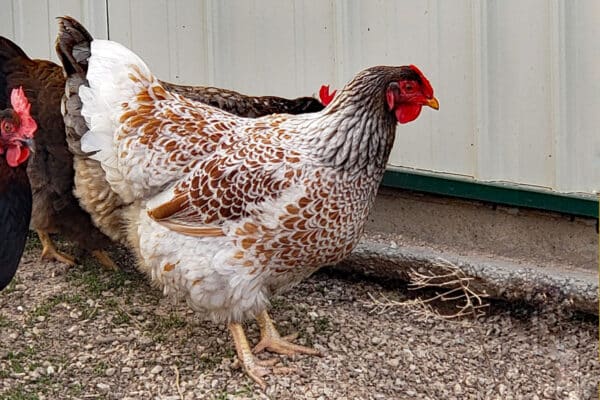
Raising Chickens – Things to Consider
Before you start your flock, you need to decide whether you want birds for egg production, meat birds, or dual purpose birds. Then, you need to determine the number of chickens you want to raise, and whether to start with fertilized eggs or baby chicks. Finally, you need to cover the basics – shelter, food, and clean water.
Make sure Chickens are Legal in your Area
Check with local ordinances to make sure it's okay to raise chickens in your area. Some municipalities only allow a certain number of birds, or allow laying hens but not roosters.
Do you want eggs, meat, or both?
The taste of home raised eggs easily beats the flavor of store bought eggs. Plus, you know they're fresh, unlike supermarket eggs, which may be up to 2 months old. Many first time chicken owners start with laying hens because they don't want to do butchering.
If you're thinking about dual purpose birds, you may want to try cooking up a dual purpose bird from a local producer first. Chickens marketed as dual purpose mature more slowly than those marketed for meat. The processed birds look much different than those found in the grocery store. They are leaner, and the meat is firmer.
We'll be focusing on egg laying hens for this article, but you can learn more about meat chickens here.
Some of the best egg layers are Leghorns, Red Stars, Rhode Island Reds, Black Australorps, and Whiting True Blues . Check out Best Laying Hens for a comparison of different chicken breeds.
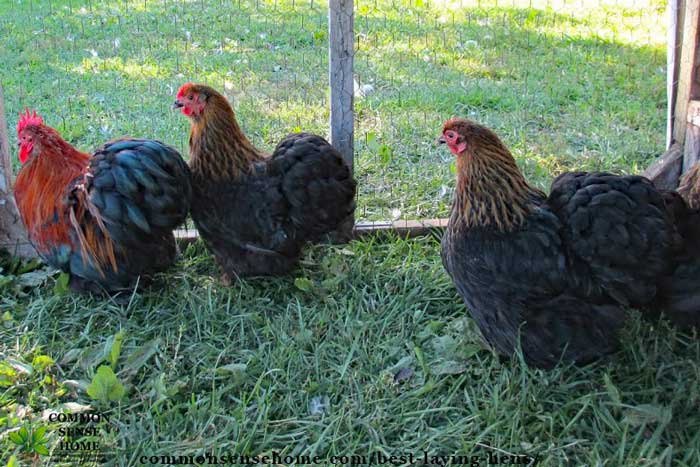
How Many Chickens Should you Raise?
Chickens like hanging out with other chickens, so it's best to have at least three birds. On average, a single laying hen can produce around 250-300 eggs per year. For a family of four, who might consume roughly a dozen eggs per week, a flock of 4-6 hens would be sufficient. You do not need a rooster to get eggs.
Female chickens (hens) ovulates a new yolk every 24-26 hours, after laying an egg. Eggs need 26 hours to fully form, so hens lay later and later each day. Eventually they lay too late in the day to signal ovulation, and they skip a day. This is why your hens don't lay eggs every single day.
Start with Chicks or Mature Birds Instead of Eggs
I highly recommend starting with sexed chicks for your first flock. When you get female chicks (pullets), you don't have to worry about butchering or rehoming roosters. Incubating eggs can be fun, but may also be frustrating.
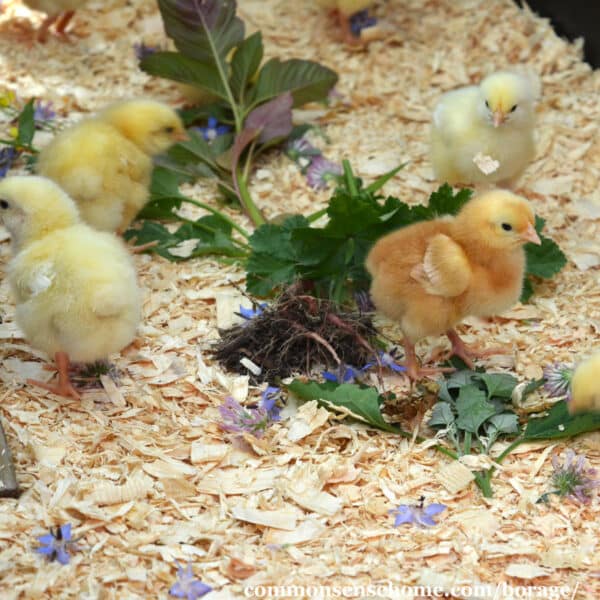
Check with your local feed stores in spring. Some have live chick displays where you can pick your chicks in store. Others allow you to order chicks and pick them up in store. You can also mail order chicks from online nurseries.
Sometimes you'll find mature laying hens for sale locally when people need to downsize their flocks. Make sure to check bird health and age. Hens may live for 6-8 years, but peak production occurs during their first two years. My grandmother raised chickens to sell eggs, and she replaced her flock each year to keep production high.
Shelter, Food, and Clean Water
Just like people or pets, chickens need shelter, food, and clean water. The needs of chicks are different than the needs of adult chickens.
Shelter – Begin with a Brooder, End with a Coop
When you bring those baby chicks home, they can't go straight into a coop without some special preps. Instead, you need to start with brooder space.

A chicken brooder is an enclosure or space specifically designed to provide warmth and shelter to newly hatched chicks. Brooders nurture chicks until they can regulate their body temperature and thrive independently in a coop or outdoors.
Chicks need extra heat for 3-6 weeks, depending on the environment. For the first week, start with a warm area kept at around 95°F (35°C). You can lower the temperature around 5 degrees per week, until they are fully feathered at around 6 weeks.
To provide heat, you can use a heat lamp or radiant heater specifically designed for chicks. For small groups of chicks, you can even use a hot water bottle. The radiant heaters are more expensive, but safer than heat lamps.
We keep our chicks inside in a large cardboard box for about a week before moving them out to the coop. Some people raise them in totes, or large water troughs, or a protected area in the coop.
Whatever you choose, make sure the chicks are protected from predators and drafts. Avoid using sawdust for bedding, as the chicks may eat it. Larger flake bedding or pellet bedding is better.
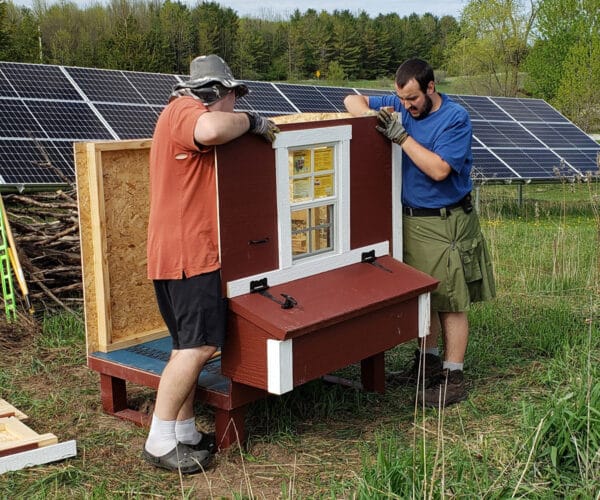
For raising chickens as they grow out of chick stage, your chicken coop needs:
- protection from predators
- a place to roost
- nesting boxes (for layers)
- a dust bath
- room to move around
Ideally, each chicken should have at least 2-3 square feet of coop space, and 8-10 square feet of outdoor space to roam.
You can convert an existing building, use a chicken tractor, buy a coop, or build a coop. Easy Coops has DIY chicken coop plans for flocks of all sizes.
Feeding Your Flock
The easiest way to make sure your chickens get the nutrients they need is to use commercial chicken feed. Like their shelter, adults need something a little different than chicks.
Chicks are growing fast, so their feed has more protein. Look for “starter/grower feed” for the fluffy bundles. Once they are old enough to lay eggs (around 20 weeks), transition to layer feed.
Layer feed has more calcium to help with egg production. We also offer crushed oyster shells and/or crushed egg shells free choice for calcium and grit.
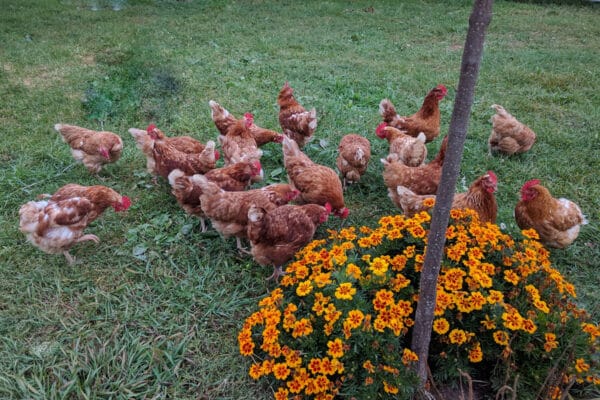
Make sure your chickens get outside time to free range or in a run with access to forage. This will help reduce your food costs. Chickens like garden scraps and table scraps, too. If you want to mix your own balanced flock ration, check out The Small Scale Poultry Flock for recipes.
Don't go overboard with rich treats like mealworms or soldier fly larvae. Too many treats can lead to health issues. See “What to Feed Chickens” for more details on safe foods.
Don't let the chickens in the garden during the growing season. They like to dig and take a taste of almost everything. Instead, put them on cleanup duty once the season wraps up, or let them dig in the beds before planting.
Provide food in a trough, bowl, commercial feeder, or DIY feeder. Chickens love to dig and scratch, so it can be helpful to have an elevated feeder to keep the bedding out of the food. Some people suggest keeping food out of the coop for cleanliness, but our girls sometimes get stuck inside due to the cold weather. Not feeding them inside is not an option.
Clean Water
Fresh, clean water is critical for flock health. Commercial waterers are easy to use, easy to clean, and come in several sizes.
We like to add a little raw apple cider vinegar to our flock water, so we use plastic waterers. (Vinegar will corrode metal waterers.) I prefer a waterer that has a large enough opening that I can get my hand inside to scrub it.
In summer, you made need an extra waterer, or even a kiddy pool to help the flock deal with extreme temps. In winter, make sure their water doesn't freeze. We swap out waterers once or twice a day, as needed, or use a heated waterer. There are plug in poultry waterers, or you can use a heated dog dish.
How soon will I get eggs?
One of the best parts of raising chickens is the eggs, but when do they start? Hens will lay eggs at around 20 weeks old (about 4 1/2 months). They will continue laying for years, taking breaks for molting and low light days.
Chickens need about 14 to 16 hours of daylight to stimulate egg production. This maximizes egg production near summer solstice, when the days are long and warm. That way, chicks hatch in spring and have time to mature while it's warm.
If you get your chicks later in the season, and they hit the 20 week mark in the middle of winter, they may not start laying until closer to spring.
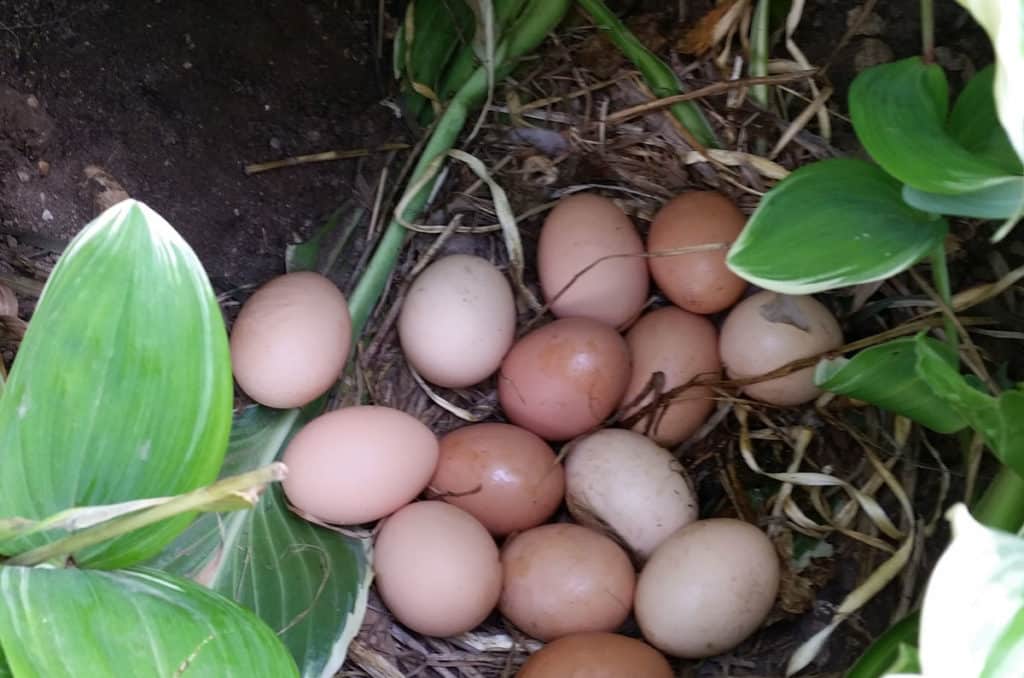
To increase egg production, some people add light to the coop. If you want to add light, use a light on a timer in the early morning, so the birds have 15 hours of light.
We personally don't add light in the coop, because I figure the birds need some rest. The birds typically molt when the days get shorter, too, so they need energy for new feathers.
If more eggs is the priority, opt for sex link chickens bred to be heavy layers. Red stars, Red Comets, ISA browns are some of crosses that are bred for maximum egg production. These birds produce an amazing number of eggs, without supplemental lighting.
See also: “When do chickens start laying eggs? (And why do they stop?)“
Is it cheaper to raise chickens or buy eggs?
Odds are that you can buy eggs cheaper than you can raise chickens. That said, I prefer the flavor and freshness of home raised eggs. I also like knowing that our birds get plenty of fresh air and sunshine.
For tips on raising chickens on a tight budget, see “How to Raise Chickens Cheaply“.
Daily Care & Hygiene
Raising chickens is a lot easier than raising some other homestead animals, but they still need daily care.
We have a morning routine that includes checking the feeder and waterer, checking for eggs, and spot cleaning. Midday we do a quick check of food and water, and look for eggs. (This check is more for the ducks than the chickens.) In the evening, we do one more egg check, and both flocks get tucked securely in the coop for the night.
We have a quick lock door on the coop that we built ourselves. Automatic chicken doors are helpful for those who can't be home to open and close the coop at specific times.
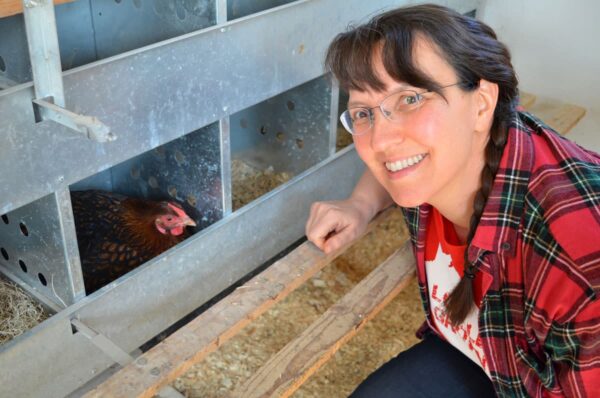
Keeping nest boxes clean and fresh means you rarely need to wash eggs, which saves time. (In wet conditions, the hens may still track mud into the nest boxes.) I like to add fresh herbs like sage, oregano, or wormwood to boxes to help deter mites and other pests. Dust bins or an outdoor dusting area help chickens maintain plumage and skin health.
It's important to maintain good air flow in your chicken coop, and avoid dampness and mold. Chickens have sensitivity respiratory systems, and a musty coop can lead to health problems. If your coop is stinky, you need to change up your chicken care routine.
We use the deep litter method, adding or flipping bedding as needed to keep it composting. With small flocks, you can spot clean droppings with a cat litter scooper instead of replacing all the bedding.
Remember, chicken droppings need to be composted before adding them to the garden. The dropping are high in nitrogen, and can burn plants or potentially spread disease if applied fresh. See “Composting 101” for tips on managing your compost.
Are you ready to start raising chickens?
Remember, you don't need a chicken palace to keep a few laying hens. Just cover the basics, and you'll be on your way to a happy, healthy flock.
To take your flock care to the next level, check out, “50 Do-It-Yourself Projects for Keeping Chickens“. This handy book includes handy ideas such as forage planters and chicken first aid. Enjoy your backyard chicken adventure!

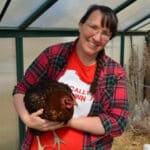
This article is by Laurie Neverman. Laurie grew up on a small dairy farm in northwest Wisconsin, and now lives on a 35 acre homestead in northeast Wisconsin. Their family raises meat chickens, laying hens, and ducks. They use solar water heating and line drying, root cellaring and freeze drying, annual gardens and permaculture.


Quick question. I bought fall chicks and they go in the coop in about a week. It will be mid 60’s during the day and lower 50’s at night … will the heated water bowl help keep them warm enough?
I have not tried a heated water dish to keep chicks warm, but I would not recommend it. They may be tempted to crawl in to keep warm and drown.
The article “How Long Do Chicks Need a Heat Lamp?” provides the following recommendations:
stay outside the brooder more than
a couple minutes.
heat lamp is secure and can’t be reached.
if the weather is nice and warm.
keep a close eye on them.
spend all day outside unless weather is
cold and rainy.
lower. Acclimate them before putting outside
for good. Be sure coops are draft-free.
I agree with the advice except the heat lamp when your temperatures drop. Chickens run a body temperatures of 105- 107*, if you heat your coop they will not make as much of the inner coat of feathers, the down, power can go out then * Bam* you lose birds to freezeing temperatures. People in Alaska don’t heat their coops either. You can build a insulated coop for you winter time temperatures, all vents lower closeable for winter and all other venting above the roosts, allowing moist air to escape keeping frost bite away from your flock. Picking cold tolerant birds is important, buckeyes..a bird with a small comb. If you must provide heat for another reason stay away from heat lamps, barns , coops and birds are lost every year to these. Much safer are radient heater plates that can be used hanging standing upright heat side facing to the flock, or on legs for brooders.
I hang my waterer in the coop in winter and hang my red heat lamp above it to keep from freezing.
I had chicken a number of years ago, but don’t have any at this time. I like the methodology there using on the back to eden utube videos as well. Some good insight here also. I had a chicken run that went aprox 100 feet layed out in a square and inside the enclosure had a garden. The end result was the chicken run circled the garden area and I was able to dive in over top of culverts used as part of the run. It was a very good way to keep things out of the garden and chicken manuer went to the garden. There is a plan for such on line and was once published by readers digest. I recommend if anyone out there has a space where they would like to raise chickens and do some gardening as well. I do plan on doing this again in my retirement years if possible. Like the heated water bowl idea;would have solved one of the problems I had with water freezing in the winter.
I gather bagged leaves in the city for fall,to put into chicken house to keep them warm. Of course, I put them into the rabbits cages to find them gone. Rabbits were eating them. They do help keep the draft in the houses warm and can be put back outside when you need a clean bag to put back into the chicken house. It helps the city people get rid of leaves and helps the cost of buying straw at six dollars a bale. Just fill your truck up with bagged leaves and they will help save you money.
Unfortunately there is a modest risk with leaves gathered from random locations because of all the nasty chemicals people on their yards. That said, if you can get safe leaves, they make great bedding. We filled our coop and our greenhouse with leaves from a friend’s yard last fall, and over the course of the winter the duckies helped break them down and load them with manure so they were a great addition to the garden and greenhouse this spring.
My girls have been in the out side coop for two weeks I haven’t put anything in the nesting boxes yet. When should I ?
It’s probably a good idea to add a little something to make them feel welcome.
Great tips you’ve shared here in your article. You are right about choosing designs for chicken coops. I almost succumb into the temptation of choosing coop designs which are not only costly to build but also too big for starters of 3-4 chickens. I’ll take your word for choosing dual breeds. who I’d also like to add that when planning for the design of the nesting boxes, it will be better if we can access the nesting boxes from the outside too. This way we can gather eggs, without enter the coop thereby leaving your chickens at peace who might still want some “quiet” moments among themselves.
In our climate, additional weather-proofing outweighs easy egg access in many situations, but whatever works best for you in your location is the right choice.
Do you have to have a rooster in order for hens to produce eggs? Will chicken’s fly over my fence if I get them? (Forgive my ignorance)If I just wanted 2 laying hens is this okay..
Kathy – that’s a common question. 🙂 No, you don’t need a rooster to produce eggs, and many municipalities that allow chickens don’t allow roosters, because they tend to be much more vocal. For some reason 5am wakeup calls are not always popular with the neighbors. 😉
We love our chickie girls!! And I’m so glad they just started laying again now that it’s warmer! They’ve had quite a traumatic start to life though. We started with 6 – one died right away and then we lost 3 to raccoons. Our two girls who are left though, are best of friends, ornery enough to drive off any predators (although they are much better protected now) and really really really good layers.
I have a question though, if anyone has an answer- I built our coop – it has 4 nesting boxes (for future birds too) and a roost. It’s working fine, except that they roost and poop in the nesting boxes. AFTER I built the coop, I read that if the nesting boxes are lower than the roost, they won’t poop in them. So, my mistake there.
Since then I’ve seen some people have nesting boxes that are totally separate from the coop- my question is- if I remove the boxes from the existing coop will they go lay in the new boxes? How can I convince them to lay in there? Are there any downsides to having nesting boxes separate from the coop? Any thoughts?
Thank you so much for this article – its a great one!
Do you have room to put up the boxes and give it a try while still leaving the old ones in place? That would be one way to find out.
I do have space… I will give that a try. Also, I only have 2 laying girls right now, so I can also focus on getting the younger girls to lay in the separate boxes when it’s time. They’re still inside with us. 🙂 Thank you Laurie!!
You’re welcome! Have a great weekend.
My problem as far as #6 goes is that my ladies love to go out and play/stand in any mud they can find after a rain. So for a day or two after a good storm, they come back into the coop with their feet caked in mud, get in the nestbox, roll the eggs around…then lay. So all the eggs in that box end up with muddy streaks all over them. I’d either throw away nearly 30 eggs, or wash them. I just wet a clean rag and run it over the egg. All our eggs are sold/consumed within a week of being laid so I’m not too concerned with the bacteria portion.
Great article!
I cannot wait till we move and can have chickens…I will keep this post in my favorites! Thank you for taking the time to share your tips for those of us just beginning!!
So glad to hear that you have found that the heated dog bowls work well for you too! We priced the heated metal waterer base AND the metal waterer and it would have been close to 90 bucks! Compare that to our lovely dog bowl at just $15 🙂 That choice was easy for us. We have 50 chickens and 5 ducks and it works great for them – they (surprisingly) don’t make a huge mess!
So does this mean your going to start raising chickens with all this info you provided?
Deb said she may give me some loaners for the summer. Still waiting to hear back on husband’s job situation. He was turned down for one spot already. (Dislike)
Thanks to everyone for chiming in. My friend, Deb, left a couple of comments on the Facebook page I thought I would share here:
“Ameraucauna, not Araucana. Araucaunas are rumpless and have eartufts. Ameraucaunas were developed from Araucaunas because of a lethal gene in the Araucaunas which results in lowered chick survival. (Deb and her family raise show birds so they are very attentive to the details of breed identification.)
Washing eggs: I have yet to have anyone complain that I washed the eggs, or complain because they did not last long enough. If you are using them for hatching, then for sure, do NOT WASH them. But true to form, even there, there is controversy. Some do not want to put dirty eggs into their incubators and risk contamination from batch to batch, and they actually do a rinse with something like an iodine wash! Washing your eggs or not is pretty much a personal decision. Now, my eggs may not last three months, but then I want them eaten LONG before that anyway!”
As for the eggshell/no eggshells question, my mom always fed her chickens the eggshells, as well as oyster shells. She did no special prep work on the shells, simply chucking them into an empty coffee can and crushing them down, and then dumping them out to the chickens when the can was full. Of course, this was around 20 years ago, when we didn’t have quite so many pathogens to content with for livestock.
Diane – I’m pining for Light Brahmas, too. 🙂
Good day. do you had a feeding program for native chickens. for example a new hatched egg. how many grams of chick starter will i gave to the chicks day.
example only
1 chick = 10 grams og starter for 1-2 weeks
and for succeeding weeks?
Feed consumption with vary greatly depending on breed, conditions and available forage. Nutrena feeds gives the following rough guidelines:
Feeding Amounts for Newly Hatched Birds:
There’s a converter at this website – http://www.metric-conversions.org/weight/ to convert pounds to kilograms/grams.
We are hoping to get light brahmas too. Are dad is considering it, but I hope all this is useful. ???? From what I’ve heard, this is great advice. ????????
My lt. Bramas were pretty but the leg feathers would get big chunks of snow caked on them and I would have to pull it off, also mud sticks to those leg feathers. I will never have another chicken with leg feathers.
I must recommend the website http://www.backyardchickens.com Their beginners info (Learning Center) and forum pages are indispensable.
To the person who asked about eggshells: no, it’s not a problem giving them back their eggshells if you crush them up. We grind ours in a mortar and pestle so they can eat it more easily. Just don’t give them any raw eggs to eat because that WILL teach them to be egg-eaters.
We’ve had chickens (eggs & meat) for years and love them. Well, not love them in squeeze ’em & hug ’em & love ’em forever kind of way. More in a get in my belly kind of way.
We love Light Brahmas the best but Buff Orps & good ol’ Easter Eggers come in tied for a close second. We also have several other dual-purpose breeds. They all interbreed to produce great dual purpose offspring. We used to have BR and RIR but didn’t care for them.
We use the deep litter method and built an open-air chicken house (http://speedkin.com/2010/12/08/the-new-fresh-air-chicken-coop-2/). We live in northern Missouri where it gets pretty darn cold and haven’t lost a bird to the cold yet. No supplemental heat.
We don’t use additional light in the winter, preferring to give them a break. We do need to get something figured out for heated water, though! Good grief, it’s been a major pain every winter. We’ve looked at all of the options but just never committed to anything yet.
I use a black ceramic infrared heat emmiter to heat chicken house by ayalight can order on Amazon – only comes in 100 and 150 watt depending on size of coup- I have a large coop so I use two 150 watt bulbs- that way girls get a break from laying – I use heated dog water bowls in winter and ice ones in summer- my chicken area is large and we. Buried strong 6 ft wire fence 8 inches underground also need to put wire under gate
I’ve heard conflicting reports on feeding chickens eggshells. Some folks think they will develop a taste for them and start eating their own eggs. What have you experienced with this?
Melanie,
I’ve never had a problem with this causing them to eat their eggs. I wrote an entire post on how I prepare the shells to be extra cautious, though– you can read it here: http://www.theprairiehomestead.com/2011/10/can-you-feed-eggshells-to-chickens.html
I’ve chatted with a lot of people about it, and there seems to be more people that feed eggshells than who do not. However, each flock is different. 🙂
Great article – thanks for the tips! We are soon to be first time chix owners 😉
I LOVE my girls! My advice, make your coop bigger than you think you think you need. They like the room and once you get some chickens, you will probably want more!!!!
I agree with you 100%. You can start out small if you want but 2 chickens turn into 3 and 3 turn into 4. The next thing you know you have a yard full of chickens and a coup the size of a buick. LOL.
We love our chickens and so do the girls
~~Samantha
Good advice. I have both the NH Reds and Blacks, they are really good layers, 24 hens = 18 to 21 eggs a day. Another thing you can do when changing out little, is to just break off the leaves of the straw and put them in the coop, let them spread it around, saves time and gives them something to do. I have a heater for my waterer, as we get pretty cold, though this winter has been quite mild. I also give my girls crushed eggs shells, saves on buying oyster shells. As spring approaches they will get to free range, but for now we still have snow on the ground, so I keep them in the yard. I look forward to them helping me weed and getting the grasshoppers. We were given an old, old sheep herders shed and we turned that into a coop, DH made their nests, and 2 x 4 make up their roosts. Visit my blog to see their digs. I have also considered putting in a grain growing bed in their run, thus letting them have greens even if I can’t let them out, which I did see via your pintrest http://pinterest.com/pin/71424344060055228/
Great post! Makes me miss my ‘little ladies’! We had 5 hens last year for the first time. My husband built a simple coop for them, and they had free range in our fenced backyard (we live right in the heart of the city for now). It was so much fun having them, and a great learning experience for all of us! Our 3 daughters loved them, and didn’t even complain about taking care of the coop! 🙂 But, when it got cold, and because we’re hoping to sell our house soon, we butchered them in November. 🙁 We can’t wait ’til the day when we can have chickens again! 🙂